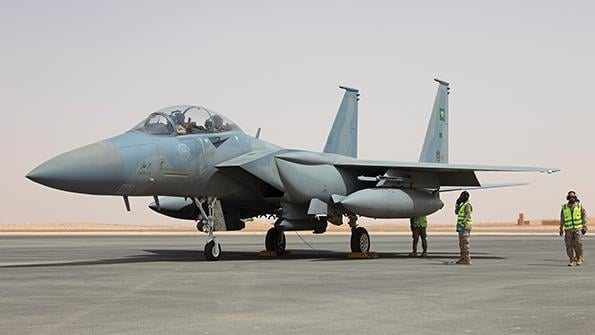Geopolitics, Supply Chain Delays Slow Gulf State Fighter Modernization

Saudi-funded development of the advanced fly-by-wire F-15SA (pictured) has resulted in a renaissance for the Eagle. Now Boeing is hoping to sell the F-15EX there as a replacement for Royal Saudi Air Force F-15C/Ds.
Some countries in the Middle East may have largely settled their combat aircraft plans, but regional turmoil, geopolitics and the supply chain appear to be challenging deliveries and holding up modernization programs.
Across the region, air forces are growing fleets and boosting capabilities—exponentially, in the case of Qatar—in recognition of the threat posed by Iran and its proxies. The moves are perhaps also an acknowledgment that the U.S.—despite ongoing events in Israel and Gaza—is pivoting away from the region to focus on the Pacific and Europe following Russia’s invasion of Ukraine.
- The region’s air forces take an expeditionary approach to fighter operations
- Embargoes and relations with Washington affect Saudi combat aircraft plans
- Political instability delays Kuwaiti Super Hornet deliveries
Today, Gulf state air forces are no longer simply a tool for national defense or a means of displaying muscle to neighbors. Increasingly, they are being used for expeditionary operations as well.
In October, Saudi Boeing F-15SA Eagles operated alongside Turkish Lockheed Martin F-16s and Pakistani Chengdu J-10s and JF-17s for the Pakistani Indus Shield Exercise, and Qatar deployed several of its Eurofighter Typhoons in May to Turkey’s Anatolian Eagle drills, where they operated alongside F-16E/Fs from the United Arab Emirates (UAE). The UAE has deployed its Mirages to Egypt for operations in Libya, too, and a Saudi-led coalition brought together aircraft from across the Gulf Cooperation Council for operations in Yemen, a conflict Riyadh is now eager to end.
“Middle Eastern countries continue to seek high-end, high-technology capabilities,” Douglas Barrie, senior fellow for military aerospace at the London-based International Institute for Strategic Studies, tells Aviation Week.
The most advanced fighters, such as the Lockheed Martin F-35, are still closed off to many regional players, so a number of them are turning to the next-best thing: more advanced variants of fourth-generation platforms. European combat aircraft often enjoy significant sales in the region because they come with weapon packages that include standoff cruise missiles the U.S. is reluctant to provide.
Barrie notes there are questions about how easily these nations can grow their air forces, as some in the region—for example, Saudi Arabia—remain heavily dependent on support from contractors such as BAE Systems.
With the largest air force in the region, Saudi Arabia is continuing its fighter modernization, moving toward what appears to be a two-type fleet made up of Boeing’s F-15 in various versions and the Eurofighter Typhoon. The Panavia Tornado is likely to leave the fleet by the end of the decade in line with the remaining European operators, Germany, and Italy.
Boeing has delivered all of Riyadh’s F-15SAs, the modernized fly-by-wire version of the aircraft that has helped to renew the Eagle’s export opportunities and led to the development of the F-15EX being purchased by the U.S.
But uncertainty surrounds the conversion process of the Royal Saudi Air Force’s F-15S fleet—a downgraded F-15E Strike Eagle variant purchased in the early 1990s—and its conversion to the F-15SR standard, due to several apparent upheavals associated with Alsalam Aerospace Industries, which is performing the work. Among these challenges is that Alsalam is transitioning to new management as it moves under the umbrella of Saudi Arabian Military Industries, the conglomerate that will run much of Saudi Arabia’s defense industry and joint ventures.
Another disruption may follow, as the site at Riyadh’s King Khalid International Airport where Alsalam performs the conversion work now sits inside the planned site of the new giant King Salman International Airport, announced by Crown Prince Mohammed bin Salman last November. This development is expected to force Alsalam to relocate before the work on F-15SRs is complete. Aviation Week analysts conservatively estimate that about 30 of the 68 F-15Ss believed to be still operational have been converted to the F-15SR standard, and others are in the conversion process.